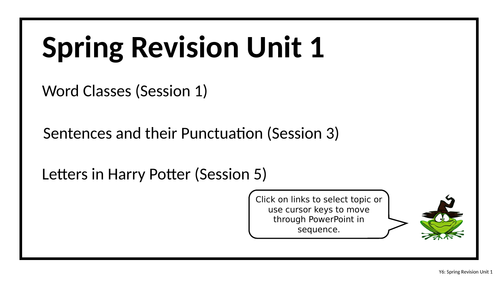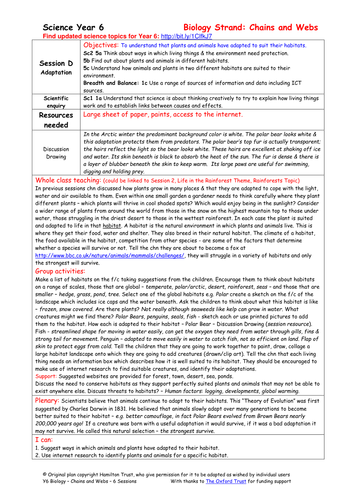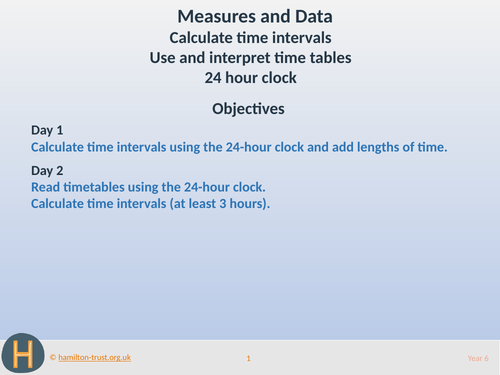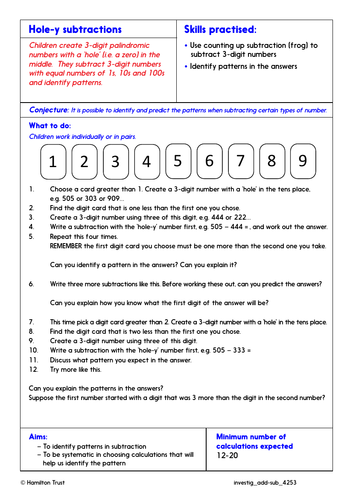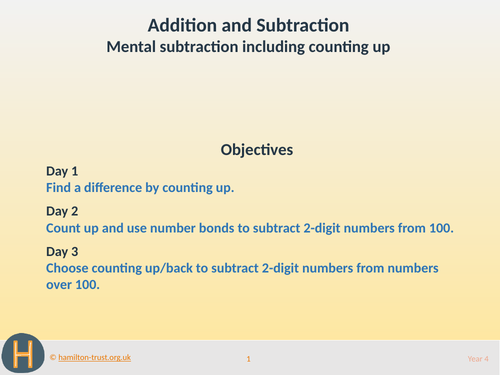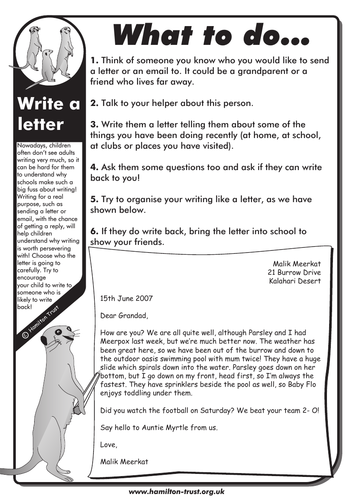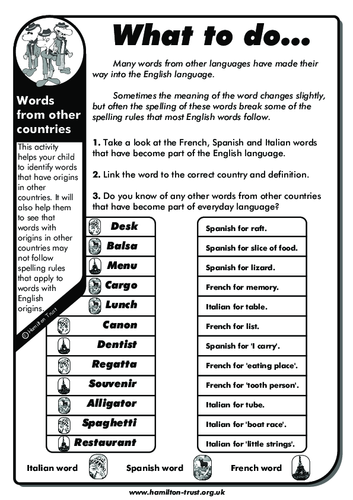
3k+Uploads
10010k+Views
11618k+Downloads

Adaptation
Did you know that Polar Bears don’t actually have white fur? But what they do have are many other adaptations that make them well suited to the Polar habitat. Children identify how other creatures have adapted to their habitat. Suitable for Y6 pupils.

Batik Technique
Introduce children to the techniques of flour resist batik and explore the history of batik in Africa. Children get a chance to practise the methods themselves.

Family Food
Consider where the food that we eat comes from. Grown at home, locally or in another country? Discuss food miles. Who does the shopping, cooking, washing up? Where does the water come from? Cook a meal/dish and write the recipe to send to your link school. Suitable for years 5 and 6.

Time intervals, timetables, 24-hour clock - Teaching Presentation - Year 6
This presentation provides two days of teaching that cover the objectives:
Calculate time intervals
Use and interpret time tables
24 hour clock
It includes starter activities, whole class teaching, group activities, practice sheets and mastery questions. It can be used on a variety of interactive whiteboards.
Day 1 Teaching
Revise the 24-hour clock, converting from am and pm times to the 24-hour clock. Find differences between times that children have written, demonstrating how to count up along a time line.
Day 2 Teaching
Display the timetable of trains from Thurso (see resources). Discuss how we can work out how long particular parts of the journey take. Count up to calculate time intervals.
This teaching is part of Hamilton’s Year 6 Measures and Data block. Each Hamilton maths block contains a complete set of planning and resources to teach a term’s worth of objectives for one of the National Curriculum for England’s maths areas.

Use short/long division in problems - Problem-Solving Investigation - Year 6
This in-depth maths investigation is an open-ended problem solving activity for Year 6 children. It can be used to support teaching towards the multiplication and division objective: use short and long division to solve problems.
In-depth Investigation: Why is it so?
Children identify a pattern in the division of a total of six numbers created using the same 3 digits. They then use algebra to explain why it is so.
This investigation will develop maths meta-skills, support open-ended questioning and logical reasoning, and enable children to learn to think mathematically and articulate mathematical ideas.
This problem-solving investigation is part of our Year 6 Multiplication and Division block. Each Hamilton maths block contains a complete set of planning and resources to teach a term’s worth of objectives for one of the National Curriculum for England’s maths areas.

Make it negative! - English Homework - UKS2
English Homework activity for UKS2:
Use suffixes and prefixes to extend vocabulary and improve spelling. Children would benefit from taking home or using dictionaries.
Looking for English planning? Using high quality texts as a starting point, our creative and stimulating English plans incorporate grammar teaching in context and offer meaningful writing opportunities. Find out more at Hamilton Trust.

Problem-Solving Investigation: Count to 20. (Year 1 Place Value)
Year 1 Place Value: Partition teen numbers; compare numbers to 20.
This in-depth Maths Investigation will develop maths meta-skills, and enable children to learn to think mathematically and articulate mathematical ideas.
In-depth Investigation: Fill in the Box
Children fill a matchbox with items and count them accurately.
This problem-solving investigation is part of our Year 1 Place Value block. Hamilton’s maths blocks present everything you need to teach a term’s worth of each required maths area together in one place.

Problem-Solving Investigation: Written subtraction (Year 4 Addition and Subtraction)
Year 4 Addition and Subtraction: Written subtraction
This in-depth maths investigation will develop maths meta-skills, and enable children to learn to think mathematically and articulate mathematical ideas.
In-depth Investigation: Hole-y Subtractions
Children create 3-digit palindromic numbers with a ‘hole’ (i.e. a zero) in the middle. They subtract 3-digit numbers with equal numbers of 1s, 10s and 100s and identify patterns in their answers.
This problem-solving investigation is part of our Year 4 Addition and Subtraction block. Each Hamilton maths block contains a complete set of planning and resources to teach a terms worth of objectives for one of the National Curriculum for England’s maths areas.

Practice Worksheets: Place 6-digit numbers on a line; round (Year 5 Place Value)
Year 5 Place Value: Place value in 6-digit numbers. Placing on a line and rounding.
Procedural fluency Practice Worksheets to achieve maths mastery. Differentiated for children working towards Age Related Expectations (ARE), at ARE and at greater depth.
Day 1
Write 6-digit numbers with digits of given values.
Write missing digits in numbers to create ascending/descending list of 6-digit numbers.
Day 2
Add/subtract 1, 10, 100, 1000, 10,000 and 100,000; preserve inequalities.
Day 3
Place 6-digit numbers on lines and round to the nearest 100 or 1000.
These procedural fluency practice sheets are part of our Year 5 Place Value block. Each Hamilton maths block contains a complete set of planning and resources to teach a terms worth of objectives for one of the National Curriculum for England’s maths areas.

Practice Worksheets: Mixed numbers and fractions of amounts. (Year 5 Decimals and Fractions)
Year 5 Decimals and Fractions: Mixed numbers and fractions of amounts.
Procedural fluency Practice Worksheets to achieve maths mastery. Differentiated for children working towards Age Related Expectations (ARE), at ARE and at greater depth.
Day 1
Write improper fractions as mixed numbers and vice versa using images of pizzas.
Day 2
Find non-unit fractions of amounts.
These procedural fluency practice sheets are part of our Year 5 Decimals and Fractions block. Each Hamilton maths block contains a complete set of planning and resources to teach a terms worth of objectives for one of the National Curriculum for England’s maths areas.

Problem-Solving Investigation: Temperature and negative numbers. (Year 5 Measures and Data)
Year 5 Measures and Data: Understand the concept of temperature and relate to negative numbers.
This in-depth Maths Investigation will develop maths meta-skills, and enable children to learn to think mathematically and articulate mathematical ideas.
In-depth Investigation: Alternating Chains
Children create chains of alternating positive and negative numbers and explore the patterns in their totals.
This problem-solving investigation is part of our Year 5 Measures and Data block. Each Hamilton maths block contains a complete set of planning and resources to teach a terms worth of objectives for one of the National Curriculum for England’s maths areas.
Bundle

Problem-Solving Investigations for Year 3 Addition and Subtraction
These in-depth Year 3 Addition and Subtraction problem-solving investigations will develop maths meta-skills, and enable children to learn to think mathematically and articulate mathematical ideas.
These open-ended mathematical activities cover the following objectives:
Using number facts to add/subtract
Add/subtract: efficient mental strategies
Using place value to add/subtract
Mental calculation – complements to 100
Use different strategies to subtract two numbers
Add 3-digit numbers using expanded addition
Subtract 2-digit numbers from numbers over 100 using counting up
In-depth Investigation: Puzzling Squares
Children use reasoning skills to solve a number puzzle. They use numbers 0 to 7 to make a total of 10 on each side of a square.
In-depth Investigation: Twisted Subtractions
Children subtract a number which is the reverse of another, e.g. 62 - 26.
In-depth Investigation: Magic 147
Children arrange the ‘nearly numbers’ in a square so that each row and column adds to Magic 147.
In-depth Investigation: Closest to 100
Following simple rules children find ways to make 100 based on four dice throws. They practise adding four numbers with a total around 100 and use this to find a solution.
In-depth Investigation: Magic Square Differences
Children use the magic square to generate two-digit numbers and explore difference patterns.
In-depth Investigation: Expanded Elevens
Children use base 10 equipment to create 3-digit numbers to add using expanded column addition.
In-depth Investigation: Pattern Subtractions
Children subtract two-digit from three-digit numbers, by counting up, and look out for patterns in the numbers.
In-depth Investigation: Next Door Additions
Children add pairs of three-digit numbers and look for patterns in the digital roots of the answers.
These problem-solving investigations are part of our Year 3 Addition and Subtraction block. Each Hamilton maths block contains a complete set of planning and resources to teach a terms worth of objectives for one of the National Curriculum for England’s maths areas.

Mental subtraction including counting up - Teaching Presentation - Year 4
This presentation provides three days of teaching that cover the objective:
Mental subtraction including counting up
It includes starter activities, whole class teaching, group activities, practice sheets and mastery questions. It can be used on a variety of interactive whiteboards.
Day 1 Teaching
Do we remember Maths Frog? He subtracts numbers by counting up from the smaller to the larger number; Frog hops along the number line; he always hops to the next 10. Ask children to use Frog to help them work out 78 – 47. Repeat for 85 – 47.
Day 2 Teaching
Display a 0–100 landmarked line. Write 100 – 85. Children use Frog to solve this, drawing hops on the line. Repeat, subtracting 2-digit numbers from 100. Sketch a bar model to go with 100 – 82 and ask children what number is missing.
Day 3 Teaching
Write 123 – 41. Children think/pair/share how they would solve it. Model Frog counting up, and counting back mentally. Write 123 – 89, 123 – 32, 123 – 50 and discuss strategies.
This teaching is part of Hamilton’s Year 4 Addition and Subtraction block. Each Hamilton maths block contains a complete set of planning and resources to teach a term’s worth of objectives for one of the National Curriculum for England’s maths areas.

Year 6 - Harry Potter themed SATs revision plans - Unit 4 - Information & explanation texts
Six revision sessions using chapters 11-14 of Harry Potter and the Philosopher’s Stone.
Focus on chapters 11-14 of Philosopher’s Stone and information texts. Revise adverbials and parentheses; create/perform a Quidditch skirmish and write reports for the Hogwarts’ library.
Includes:
teaching plan for 5 sessions
teaching resources and answers
SPAG revision presentation
5-minute SPAG revision presentation
Session 1 - Pre-teach phrases and clauses. Read extracts from Quidditch through the ages and identify the features of different text types (explanations, non-chronological reports, recounts…). Discuss the purpose of information texts. Homework: Discuss spelling rules for these suffixes and learn lists.
Session 2 - Revise adverbials, reminding children of the difference between phrases and clauses. Children watch a film clip, and identify the features of commentary. They then write an imagined commentary using adverbials. Act out a commentary and identify the function of adverbials.
Session 3 - Consider where and how information texts occur in Harry Potter where they don’t have the internet. Revise parentheses, and then identify and punctuate these. Children write a short report, including punctuated parenthetical information.
Session 4 - Children read extracts, looking for clues as to what the mirror shows. Discuss and ensure that they’ve noticed that Erised is desire backwards. Discuss what other characters might see and then predict what we would see if we looked in the mirror, Children pick one character and make notes to share.
Session 5 - Discuss the combination of fantasy and school genres. Which elements of this extract belong to which genre? Children analyse features, make inferences, explain the meaning of words in context and answer test-style comprehension questions, giving evidence to justify opinions.
Session 6 - Discuss information texts written by Rowling: Quidditch Through the Ages and Fantastic Beasts and Where to Find Them. Remind children of the features of this type of text. They then write information texts about magical items in Harry Potter books.
SPAG Revision
Look at the difference between phrases and clauses, then move on to study adverbials, including fronted adverbials. Finally, revise parenthesis.
This unit is part of a larger block of Harry Potter themed revision plans that cover all of the required revision for the Year 6 English SATs, including the SPAG.
Bundle

English Homework (Bundle 3) - KS1
English Homework activities for Key Stage 1
Bundle 3 includes the following homework activities:
Cat cot
Favourite items of clothing
Harry hopping, Bella bouncing
Hickory dickory dock
Knock, knock, who’s there?
Listen to my dream
Massive animal!
Miaow - I’m a dog!
Moon landings
Once upon a time
Rhyming animals
Summer holiday
Looking for English planning? Using high quality texts as a starting point, our creative and stimulating English plans incorporate grammar teaching in context and offer meaningful writing opportunities. Find out more at Hamilton Trust.

Understand x 100 and ÷ 100 as inverses - Problem-Solving investigation - Year 3
Year 3 Place Value and Money: Understand multiplying and dividing by 10 and 100 (3-digit numbers) as inverse operations.
This in-depth maths investigation will develop maths meta-skills, and enable children to learn to think mathematically and articulate mathematical ideas.
In-depth Investigation: Lost Logic
Children use their knowledge of inverse operations to solve a logic problem.
This problem-solving investigation is part of our Year 3 Place Value and Money block. Each Hamilton maths block contains a complete set of planning and resources to teach a term’s worth of objectives for one of the National Curriculum for England’s maths areas.

Write a letter - English Homework - KS1
English Homework activity for KS1:
Write a short letter to a friend or relative about what they have been doing recently. Practise writing for a purpose.
Looking for English planning? Using high quality texts as a starting point, our creative and stimulating English plans incorporate grammar teaching in context and offer meaningful writing opportunities. Find out more at Hamilton Trust.

Identifying adverbials and using these to add cohesion (Presentation & Exercises) - Year 5 SPAG
Presentation and practice exercises to revise the formation and use of adverbials, including the use of prepositions and fronted adverbials. Children are then shown how these aid cohesion.
SPAG resources that cover the following grammar objectives:
– Use and understand devices to build cohesion within a paragraph (for example, then, after that, this, firstly).
– Link ideas across paragraphs using adverbials of time (for example, later).
– Use commas after fronted adverbials, to clarify meaning.
Included in this unit:
Up to 3 days of teaching.
Presentation that can be used on a variety of interactive whiteboards.
Group activity resources.
This SPAG Unit is part of a larger block on Spooky Short Stories.
Find additional teaching on Hamilton’s Year 5 English Block about Short Stories.

Words from other countries - English Homework - UKS2
English Homework activity for UKS2:
Identify words that have origins in other countries by matching words to the country and the definition.
Looking for English planning? Using high quality texts as a starting point, our creative and stimulating English plans incorporate grammar teaching in context and offer meaningful writing opportunities. Find out more at Hamilton Trust.

Letter to a newspaper - English Homework - UKS2
English Homework activity for UKS2:
Look at some letters written to newspapers and begin to understand their purpose. Write their own letter to a newspaper.
Looking for English planning? Using high quality texts as a starting point, our creative and stimulating English plans incorporate grammar teaching in context and offer meaningful writing opportunities. Find out more at Hamilton Trust.

